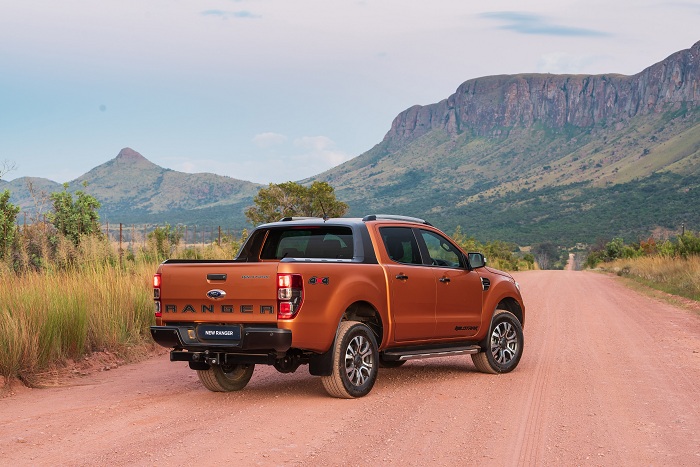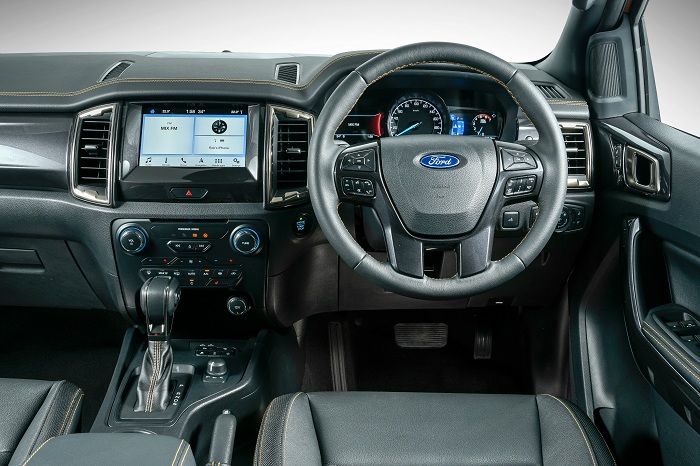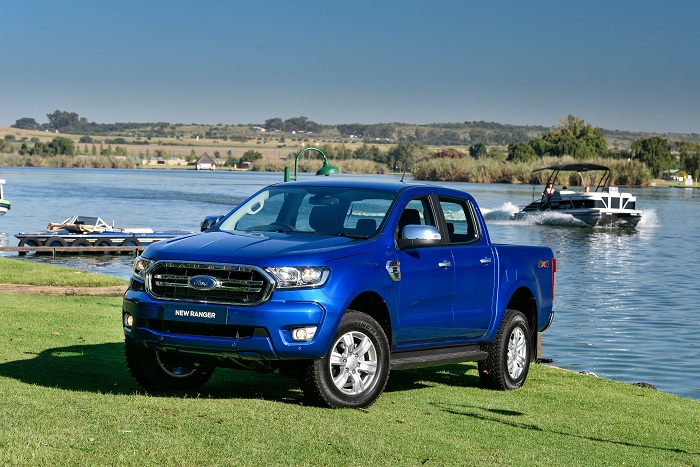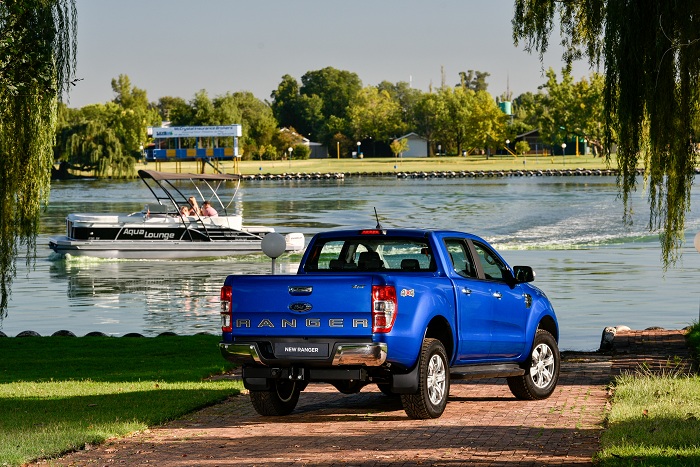The fact that the Ranger, its Everest sibling and the soon-to-be-introduced Ranger Raptor are all built at Ford’s Silverton Plant near Pretoria, clearly illustrates how relevant these products are to South Africa. I travelled down to George along the Garden Route recently to sample the updated Ranger line-up.
Exterior and interior updates

From an interior and exterior perspective, very little has changed. On the XLT model, there’s a new front grille along with a reshaped lower bumper for the XL and XLS derivatives. The ever-popular Wildtrak meanwhile now comes with HID headlamps and daytime running LEDs, additional cooling vents, a new lower bumper and redesigned fog lamp surrounds.
Inside, the changes are even less dramatic with more black inserts to create what Ford calls an “Ebony Black environment”. The Wildtrak’s interior updates are a bit more pronounced with all-black seats replacing the previous grey and orange items, along with dark-satin chrome elements.

Top-spec models (XLT and Wildtrak) also receive the brand’s SYNC 3 operating system and the carried-over eight-inch touchscreen infotainment system, while XLS models get the more basic SYNC 1 system, which is optional on the XL. Overall, the changes are very minor as only current owners and diehard fans will note the difference. That being said, the Ranger was updated some four years ago and still appears fresh amongst the current crop of bakkies.
Changes under the skin

The real reason for the launch was to demonstrate the updates made underneath the skin and indeed, in terms of specification. The real headline is a pair of new EcoBlue turbodiesel engines, both mated to a new 10-speed automatic gearbox. The first of the new engines is a single turbo displacing 2.0-litres and available on the double cab XLT 4x4. The motor produces 132 kW and 420 N.m of torque. Having sampled this drivetrain at launch, I feel that it is the combination that best suits the Ranger.
Next-up is the same motor but with the addition of a second turbocharger that pumps out 157 kW and 500 N.m. Essentially the same mill that will power the Raptor, this unit is only available on the Wildtrak 4x2 and 4x4 variants, and replaces the 3.2-litre five-cylinder as the new flagship engine option. Having sampled this at launch, the 10-speed gearbox, co-developed with General Motors, offers seamless shifts and works very well with the punchy twin-turbo motor.

The current 2.2-litre four-cylinder motors and the aforementioned five-cylinder that continues to produce 147kW and 470 N.m, are still be available in various double cab, super cab and single cab Ranger configurations, along with the familiar five-and-six-speed manual ‘boxes, as well as the optional six-speed automatic.
Other important changes include a rather noticeable improvement in the ride quality thanks to the relocation of the front anti-roll bar from the front of the suspension to behind the axle. The damper settings have also been revised to include four new damper rates, each for different front kerb weights, meaning that the damping is more suited to the application.

In addition to this, standard tyre pressure has been reduced from the previously recommended 2.4 bar to 2.1 bar, improving ride quality further. Those with towing requirements will be happy to hear that all models above the XL have a braked towing capacity of 3 500kg. The tailgate has also been made easier to lift and lower thanks to the fitment of a torsion rod which reduces operator effort by a claimed 70%. It really is a great solution with most being able to close the tailgate using only one finger.
The Ranger was the first bakkie within the local market to introduce adaptive cruise control a few years back. Now, the top-spec Wildtrak gets the semi-automatic Park Assist System along with the familiar Lane Keeping Alert, Lane Keeping Aid and Auto High Beam Control.
Verdict
While the changes made to the Ranger line-up as a whole are very minor, the updates made to the higher-spec double cab models have ensured that the Ranger is exceptionally competitive within the lifestyle double cab bakkie segment.
Service plan and warranty
All models come standard with a four-year/120 000 km warranty as well as a six year/ 90 000 km service plan.
Pricing
SINGE CAB
| MODEL | PRICE |
| Ranger 2.2 TDCi base | R287 100 |
| Ranger 2.2 TDCi XL | R359 800 |
| Ranger 2.2 TDCi XL 4x4 | R411 400 |
| Ranger 2.2 TDCi XL AT | R372 300 |
| Ranger 2.2 TDCi XLS | R390 900 |
| Ranger 2.2 TDCi XLS 4x4 AT | R449 200 |
| Ranger 3.2 TDCi XLS | R401 800 |
| Ranger 3.2 TDCi XLS 4x4 AT | R460 100 |
SUPER CAB
| MODEL | PRICE |
| Ranger 2.2 TDCi base | R336 500 |
| Ranger 2.2 TDCi XL | R381 400 |
| Ranger 2.2 TDCi XL 4x4 | R429 300 |
| Ranger 2.2 TDCi XL AT | R393 800 |
| Ranger 2.2 TDCI XLS AT | R426 900 |
| Ranger 2.2 TDCI XLS 4x4 AT | R472 400 |
| Ranger 3.2 TDCi XLS | R424 900 |
| Ranger 3.2 TDCi XLS 4x4 | R480 900 |
| Ranger 3.2 TDCi XLS 4x4 AT | R568 600 |
DOUBLE CAB
| MODEL | PRICE |
| Ranger 2.2 TDCi base | R350 000 |
| Ranger 2.2 TDCi XL | R409 900 |
| Ranger 2.2 TDCi XL 4x4 | R455 300 |
| Ranger 2.2 TDCi XL AT | R428 800 |
| Ranger 2.2 TDCi XL 4x4 AT | R474 700 |
| Ranger 2.2 TDCi XLS | R455 100 |
| Ranger 2.2 TDCi XLS 4x4 AT | R508 400 |
| Ranger 3.2 TDCi XLT | R542 600 |
| Ranger 3.2 TDCi XLT 4x4 | R604 800 |
| Ranger 3.2 TDCi XLT AT | R571 400 |
| Ranger 3.2 TDCi XLT 4x4 AT | R617 300 |
| Ranger 3.2 TDCi Wildtrak AT | R609 800 |
| Ranger 2.0 EcoBlue XLT AT | R514 300 |
| Ranger 2.0 EcoBlue XLT 4x4 AT | R570 200 |
| Ranger 2.0 EcoBlue Wildtrak AT | R632 300 |
| Ranger 2.0 EcoBlue Wildtrak 4x4 AT | R678 200 |
















